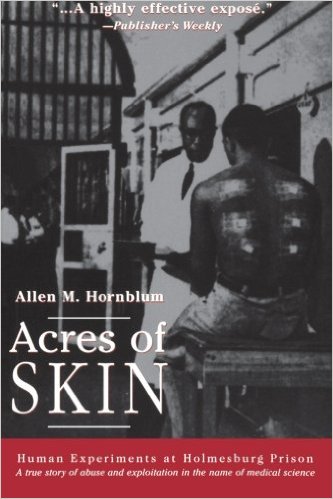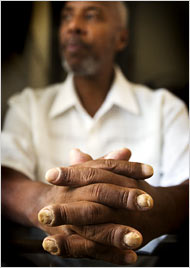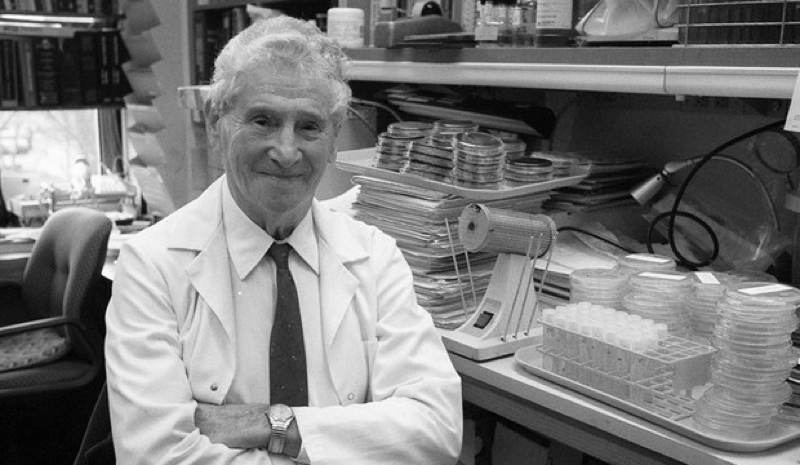

We continue to look at the horrors inflicted upon African Americans in the name of medical science and research. In today’s entry, we post an article from 1998 in the Baltimore Sun on the experiments conducted at Holmesburg Prison in the 1950s. Also posted, an article from the New York Times in 2006 on the updated cases at Holmesburg Prison and a desire to continue the horrors.

Studying prison experiments Research: For 20 years, a dermatologist used the inmates of a Philadelphia prison as the willing subjects of tests on shampoo, foot powder, deodorant, and later, mind-altering drugs and dioxin.
July 21, 1998|KNIGHT RIDDER/TRIBUNE
PHILADELPHIA — It was 1951 when the father of Retin-A first came to Holmesburg Prison.
The 1,200 inmates of Philadelphia’s gloomiest jail were plagued by an outbreak of athlete’s foot, and the prison pharamacist had asked Dr. Albert M. Kligman, a University of Pennsylvania dermatologist, to take a look.
Imagine the researcher’s thrill as he stepped into the aging prison, hundreds of men milling around.
“All I saw before me were acres of skin,” Kligman told a newspaper reporter in 1966. “It was like a farmer seeing a field for the first time.”
He had stumbled on a bonanza.

Twenty years later, Allen M. Hornblum entered the Philadelphia Detention Center to teach an adult literacy course.
Fresh out of a master’s program at Villanova University, Hornblum, then 23, was getting his first view of a tough and alien society in a noisy, claustrophobic, foul-smelling city jail.
One sight struck him as particularly strange: Scores of men, bare-chested in the heat, their backs, shoulders and arms striped with gauze pads and adhesive tape.
“The sight of that, quite frankly, never left my mind,” said Hornblum, now 50 and at the end of a long “crusade” – his word – to piece together the full story of what those bandages implied. The result is his first book, “Acres of Skin: Human Experiments at Holmesburg Prison; A True Story of Abuse and Exploitation in the Name of Medical Science” (Routledge).
The bandaged inmates were not, as Hornblum first thought, victims of some awful riot. As guards and inmates told him, the prisoners were taking part in “perfume experiments” conducted by doctors from the University of Pennsylvania. They were renting their bodies for cash.
And nobody seemed to think it unusual.
20 years of experiments
The experiments in Philadelphia’s prisons had been going on for 20 years, under Kligman’s tutelage: tests involving toothpaste, deodorant, shampoo, skin creams, detergents, liquid diets, eye drops, foot powders and hair dye, “seemingly benign,” Hornblum writes, “but accompanied by constant biopsies and frequently painful procedures.”
And there were other tests, Hornblum would later learn, involving mind-altering drugs, radioactive isotopes and dioxin.

Kligman, who is 82 and living in Philadelphia, became a wealthy man and a famous name in dermatology, the inventor of Retin-A, the acne cream and wrinkle-remover widely hailed as youth in a tube.
“The early human trials,” Hornblum writes of Retin-A, “were performed on the backs and faces of the Holmesburg inmates.”

Kligman has denied doing anything wrong. “My use of paid prisoners as research subjects in the 1950s and 1960s was in keeping with this nation’s standard protocol for conducting scientific investigations at that time,” he said in a recent )R two-sentence statement, one of the few he has made on the subject.
“To the best of my knowledge,” Kligman added, “the result of those experiments advanced our knowledge of the pathogenesis skin disease, and no long-term harm was done to any person who voluntarily participated in the research program.”
The experiments ended in 1974 as a wave of national publicity and congressional hearings put an end to most human experimentation involving populations such as prisoners and mental patients.
But Hornblum – who spent 10 years as a literacy instructor in the detention center, served on the prison system’s board of trustees and sat on the board of the Philadelphia Prison Society – remained haunted by what he’d seen at Holmesburg, the Detention Center and the House of Correction.
“It was chilling,” he said in a recent interview, “to be in a totalitarian atmosphere, which a prison is, and to see minorities – the prison was about 85 percent black and there were very few high school graduates – to see all these people involved in some medical experiment about which they had a minimal amount of information. “It just rubbed me raw.”
The idea that an injustice had gone unaddressed nagged at Hornblum ever after. Four years ago, the sometime college teacher and political adviser quit his job as chief of staff to Philadelphia Sheriff John Green. Without a book contract or a salary to fall back on, he plunged headlong into a welter of interviews, libraries and obscure documents, hoping to illuminate era that had received very little light over the years.
Hornblum is not the first critic to raise questions about the Philadelphia prison experiments. In 1979 the Philadelphia Inquirer disclosed that Holmesburg inmates had been used as guinea pigs to test whether mind-altering drugs were useful as Army weapons. In 1981 the paper reported that inmates had been dosed with dioxin to test the herbicide’s effects on human health.
But Hornblum’s account is the most extensive and detailed to date. He writes that inmates were told very little about the tests performed on them – in violation, Hornblum argues, of the Nuremberg Code adopted after World War II in reaction to Nazi medical atrocities. The code’s first statement: “The voluntary consent of the human subject is absolutely essential.”
Eager for pay
Prisoners, Hornblum writes, were more than eager to gamble their health for pay. At Holmesburg, the going rate was $10 to $300, depending on the experiment – a fortune compared with the jail’s normal wages of 15 cents or 25 cents a day.
Hornblum describes Kligman as a brilliant and entrepreneurial scientist, a pioneer in his field, a man of brimming self-confidence who told students that rules don’t apply to genius.
To Kligman, a prison population was ideal for research. “An anthropoid colony,” he called it, “mainly healthy, under perfect control conditions.”
“I began to go to the prison regularly, although I had no authorization,” Kligman said in a 1986 history of Penn’s dermatology department. “It was years before the authorities knew that I was conducting various studies on prisoner volunteers. Things were simpler then. Informed consent was unheard of. No one asked me what I was doing. It was a wonderful time.”

Before long, “Holmesburg Prison became one of America’s largest, nontherapeutic, human research factories,” Hornblum writes.
A common test was what inmates called a “patch test.” Strips of hospital tape were stuck to an inmate’s upper back, forming a grid with about 20 squares. On each square went a dab of lotion (skin cream, moisturizer, suntan lotion – a variety of products). Then came heat from a sunlamp. Doctors checked the skin for peeling, burning and blistering at different temperatures.
Withers Pond, a 79-year-old lifer, told Hornblum he once volunteered for a “gauze test.” Without anesthetic, he lay on a table while two doctors cut two 1-inch incisions on each side of his lower back, inserted gauze pads into the wounds and then stitched him up, he said. Ten days later, doctors reopened one wound, removed the gauze pad and restitched him. They removed the other gauze pad 10 days later.
Pond never learned the purpose of the exercise, but he got $20. “Now I got these scars all over my back,” he said.
“Both inmates and guards say you can recognize a Holmesburg prisoner decades later,” Hornblum writes, “by the distinctive scars from skin burns and patch tests.”
One guard told him: “Guys looked like zebras when the patches came off.”
A former inmate named Johnnie Williams told Hornblum that the mind-altering drugs he took as a Holmesburg research subject changed his personality; he went from small-time hood to violent criminal.
Hit by a car recently, Williams refused to go to a hospital. “I’m paranoid about doctors,” he told Hornblum. “I’m scared of ’em.”
For all that, there are few documented cases of long-term injury to the estimated thousands of inmates who took part in the experiments. The main reason, according to Hornblum: Kligman destroyed the records when the program was killed in 1974.
Panel Suggests Using Inmates in Drug Trials
PHILADELPHIA, Aug. 7 2006 — An influential federal panel of medical advisers has recommended that the government loosen regulations that severely limit the testing of pharmaceuticals on prison inmates, a practice that was all but stopped three decades ago after revelations of abuse. The proposed change includes provisions intended to prevent problems that plagued earlier programs.
Nevertheless, it has dredged up a painful history of medical mistreatment and incited debate among prison rights advocates and researchers about whether prisoners can truly make uncoerced decisions, given the environment they live in. Supporters of such programs cite the possibility of benefit to prison populations, and the potential for contributing to the greater good.
Until the early 1970’s, about 90 percent of all pharmaceutical products were tested on prison inmates, federal officials say. But such research diminished sharply in 1974 after revelations of abuse at prisons like Holmesburg here, where inmates were paid hundreds of dollars a month to test items as varied as dandruff treatments and dioxin, and where they were exposed to radioactive, hallucinogenic and carcinogenic chemicals.
In addition to addressing the abuses at Holmesburg, the regulations were a reaction to revelations in 1972 surrounding what the government called the Tuskegee Study of Untreated Syphilis in the Negro buy viagra in stores Male, which was begun in the 1930’s and lasted 40 years. In it, several hundred mostly illiterate men with syphilis in rural Alabama were left untreated, even after a cure was discovered, so that researchers could study the disease. “What happened at Holmesburg was just as gruesome as Tuskegee, but at Holmesburg it happened smack dab in the middle of a major city, not in some backwoods in Alabama,” said Allen M. Hornblum, an urban studies professor at Temple University and the author of “Acres of Skin,” a 1998 book about the Holmesburg research. “It just goes to show how prisons are truly distinct institutions where the walls don’t just serve to keep inmates in, they also serve to keep public eyes out.”
Critics also doubt the merits of pharmaceutical testing on prisoners who often lack basic health care. Alvin Bronstein, a Washington lawyer who helped found the National Prison Project, an American Civil Liberties Union program, said he did not believe that altering the regulations risked a return to the days of Holmesburg. “With the help of external review boards that would include a prisoner advocate,” Mr. Bronstein said, “I do believe that the potential benefits of biomedical research outweigh the potential risks.” Holmesburg closed in 1995 but was partly reopened in July to help ease overcrowding at other prisons. Under current regulations, passed in 1978, prisoners can participate in federally financed biomedical research if the experiment poses no more than “minimal” risks to the subjects.
But a report formally presented to federal officials on Aug. 1 by the Institute of Medicine of the National Academy of Sciences advised that experiments with greater risks be permitted if they had the potential to benefit prisoners. As an added precaution, the report suggested that all studies be subject to an independent review.
“The current regulations are entirely outdated and restrictive, and prisoners are being arbitrarily excluded from research that can help them,” said Ernest D. Prentice, a University of Nebraska genetics professor and the chairman of a Health and Human Services Department committee that requested the study. Mr. Prentice said the regulation revision process would begin at the committee’s next meeting, on Nov. 2.
The discussion comes as the biomedical industry is facing a shortage of testing subjects. In the last two years, several pain medications, including Vioxx and Bextra, have been pulled off the market because early testing did not include large enough numbers of patients to catch dangerous problems. And the committee’s report comes against the backdrop of a prison population that has more than quadrupled, to about 2.3 million, over the last 30 years and that disproportionately suffers from H.I.V. and hepatitis C, diseases that some researchers say could be better controlled if new research were permitted in prisons.
For Leodus Jones, a former prisoner, the report has opened old wounds. “This moves us back in a very bad direction,” said Mr. Jones, who participated in the experiments at Holmesburg in 1966 and after his release played a pivotal role in lobbying to get the regulations passed. In one experiment, Mr. Jones’s skin changed color, and he developed rashes on his back and legs where he said lotions had been tested. “The doctors told me at the time that something was seriously wrong,” said Mr. Jones, who added that he had never signed a consent form. He reached a $40,000 settlement in 1986 with the City of Philadelphia after he sued. “I never had these rashes before,” he said, “but I’ve had them ever since.”
The Institute of Medicine report was initiated in 2004 when the Health and Human Services Department asked the institute to look into the issue. The report said prisoners should be allowed to take part in federally financed clinical trials so long as the trials were in the later and less dangerous phase of Food and Drug Administration approval. It also recommended that at least half the subjects in such trials be nonprisoners, making it more difficult to test products that might scare off volunteers. Dr. A. Bernard Ackerman, a New York dermatologist who worked at Holmesburg during the 1960’s trials as a secondyear resident from the University of Pennsylvania, said he remained skeptical. “I saw it firsthand,” Dr. Ackerman said. “What started as scientific research became pure business, and no amount of regulations can prevent that from happening again.” Others cite similar concerns over the financial stake in such research.
“It strikes me as pretty ridiculous to start talking about prisoners getting access to cutting edge research and medications when they can’t even get penicillin and high blood pressure pills,” said Paul Wright, editor of Prison Legal News, an independent monthly review. “I have to imagine there are larger financial motivations here.” The demand for human test subjects has grown so much that the so called contract research industry has emerged in the past decade to recruit volunteers for pharmaceutical trials. The Tufts Center for the Study of Drug Development, a Boston policy and economic research group at Tufts University, estimated that contract research revenue grew to $7 billion in 2005, up from $1 billion in 1995. But researchers at the Institute of Medicine said their sole focus was to see if prisoners could benefit by changing the regulations. The pharmaceutical industry says it was not involved.
Jeff Trewitt, a spokesman for the Pharmaceutical Research and Manufacturers of America, a drug industry trade group, said that his organization had no role in prompting the study and that it had not had a chance to review the findings. Dr. Albert M. Kligman, who directed the experiments at Holmesburg and is now an emeritus professor of dermatology at the University of Pennsylvania Medical School, said the regulations should never have been written in the first place. “My view is that shutting the prison experiments down was a big mistake,” Dr. Kligman said. While confirming that he used radioactive materials, hallucinogenic drugs and carcinogenic materials on prisoners, Dr. Kligman said that they were always administered in extremely low doses and that the benefits to the public were overwhelming.
He cited breakthroughs like Retin A, a popular antiacne drug, and ingredients for most of the creams used to treat poison ivy. “I’m on the medical ethics committee at Penn,” he said, “and I still don’t see there having been anything wrong with what we were doing.” From 1951 to 1974, several federal agencies and more than 30 companies used Holmesburg for experiments, mostly under the auspices of the University of Pennsylvania, which had built laboratories at the prison. After the revelations about Holmesburg, it soon became clear that other universities and prisons in other states were involved in similar abuses. In October 2000, nearly 300 former inmates sued the University of Pennsylvania, Dr. Kligman, Dow Chemical and Johnson & Johnson for injuries they said occurred during the experiments at Holmesburg, but the suit was dismissed because the statute of limitations had expired.
“When they put the chemicals on me, my hands swelled up like eight ounce boxing gloves, and they’ve never gone back to normal,” said Edward Anthony, 62, a former inmate who took part in Holmesburg experiments in 1964. “We’re still pushing the lawsuit because the medical bills are still coming in for a lot of us.” Daniel S. Murphy, a professor of criminal justice at Appalachian State University in Boone, N.C., who was imprisoned for five years in the 1990’s for growing marijuana, said that loosening the regulations would be a mistake. “Free and informed consent becomes pretty questionable when prisoners don’t hold the keys to their own cells,” Professor Murphy said, “and in many cases they can’t read, yet they are signing a document that it practically takes a law degree to understand.”
During the Holmesburg experiments, inmates could earn up to $1,500 a month by participating. The only other jobs were at the commissary or in the shoe and shirt factory, where wages were usually about 15 cents to 25 cents a day, Professor Hornblum of Temple said. On the issue of compensation for inmates, the report raised concern about “undue inducements to participate in research in order to gain access to medical care or other benefits they would not normally have.” It called for “adequate protections” to avoid “attempts to coerce or manipulate participation.’’ The report also expressed worry about the absence of regulation over experiments that do not receive federal money.
Lawrence O. Gostin, the chairman of the panel that conducted the study and a professor of law and public health at Georgetown University, said he hoped to change that. Even with current regulations, oversight of such research has been difficult. In 2000, several universities were reprimanded for using federal money and conducting several hundred projects on prisoners without fully reporting the projects to the appropriate authorities. Professor Gostin said the report called for tightening some existing regulations by advising that all research involving prisoners be subject to uniform federal oversight, even if no federal funds are involved. The report also said protections should extend not just to prisoners behind bars but also to those on parole or on probation.
Professor Murphy, who testified to the panel as the report was being written, praised those proposed precautions before adding, “They’re also the parts of the report that faced the strongest resistance from federal officials, and I fear they’re most likely the parts that will end up getting cut as these recommendations become new regulations.”
Holmesburg Prison
Published on Dec 21, 2014
An interview with Allen Hornblum,Author of “Sentenced to Science”, & ” Acres of Skin”,and Yusef Anthony, former Holmesburg Prison test subject,circa 1964.
